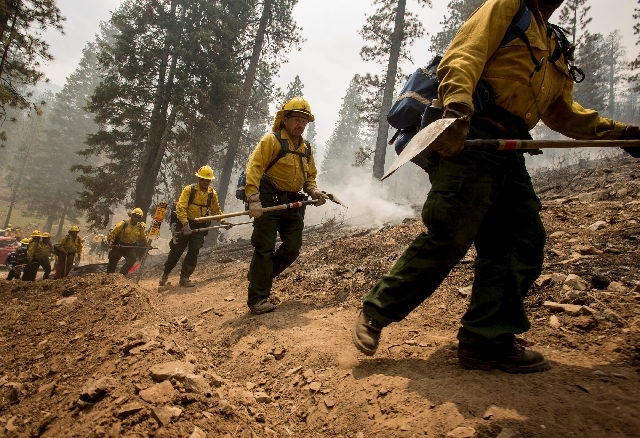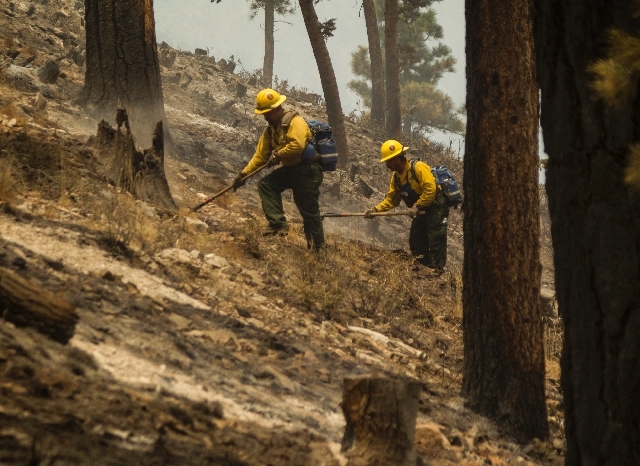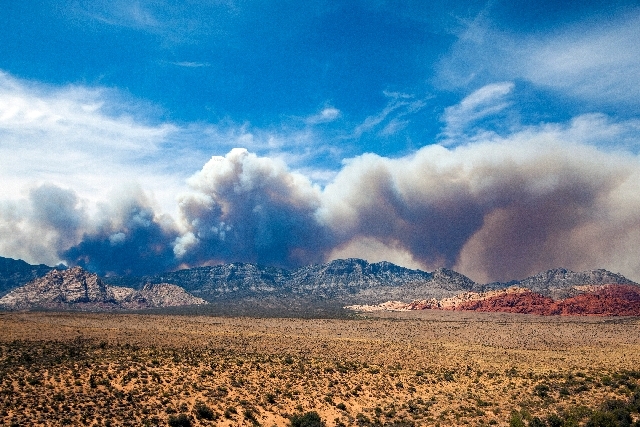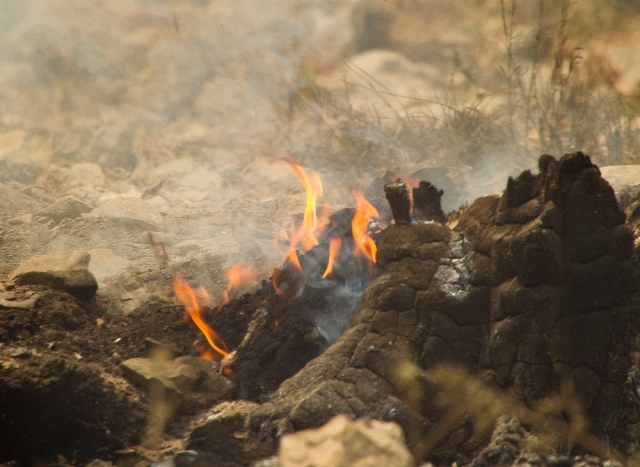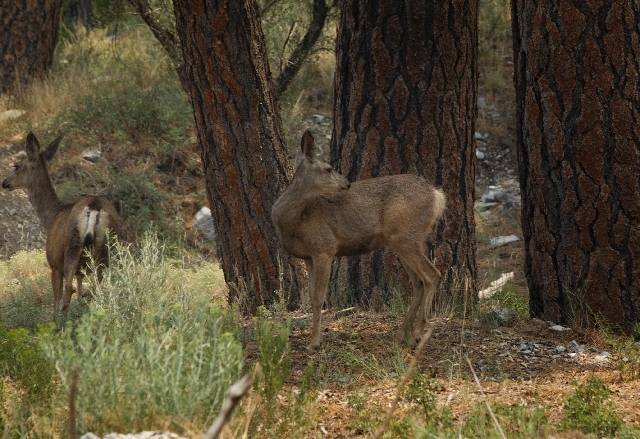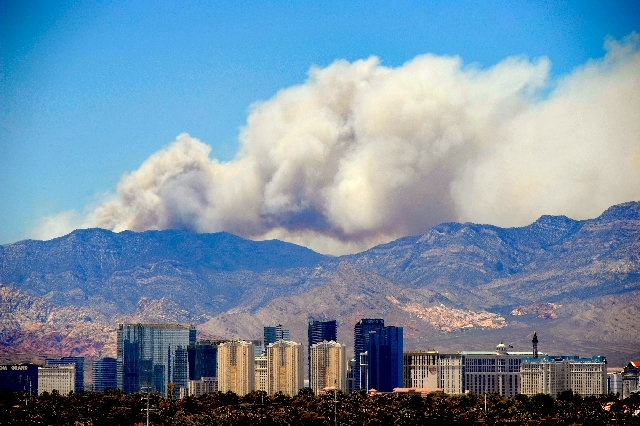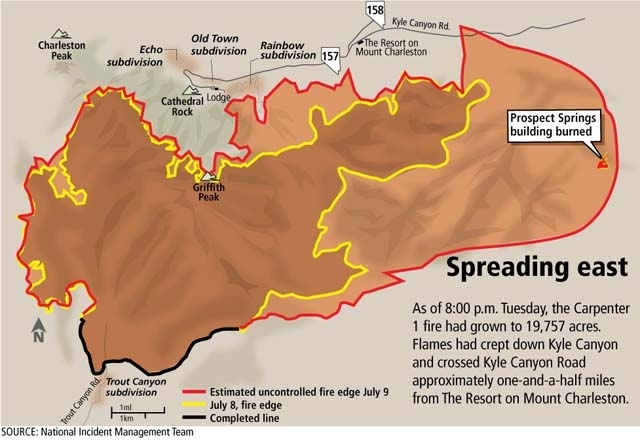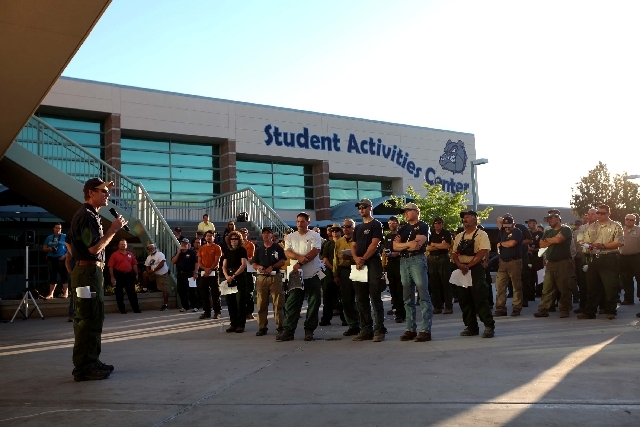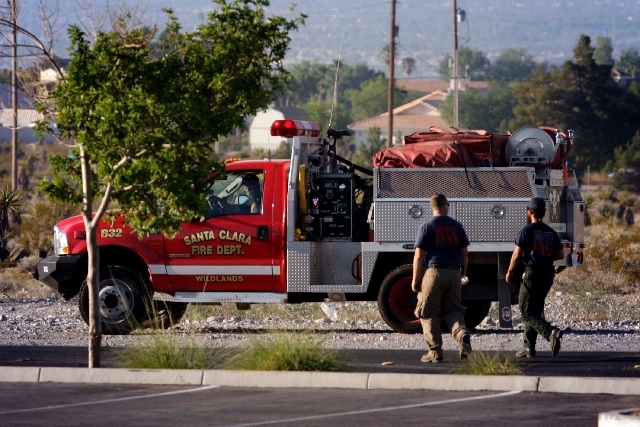Fire within sight of Kyle Canyon homes
Like sooty snow, flakes of ash flutter to the ground.
Aluminum paper wraps U.S. Forest Service buildings as if they were giant Christmas presents. The homes along Kyle Canyon Road stand empty.
A smoke-enshrouded ghost town.
From the doorsteps of the empty homes, the edge of the Carpenter 1 Fire was visible Tuesday afternoon on the blackened hills above the Rainbow subdivision south of Kyle Canyon Road. But the fire has mostly been steered east around the community, posing a potential problem greater than burnt buildings.
On Tuesday, the flames made their way past The Resort on Mount Charleston – where helicopters dip their buckets into makeshift bladders of water – and crossed over the road about two miles down canyon. While officials feel that the resort is safe from the blaze for now, a Prospect Springs commercial building was burned Tuesday, the first property damage since lightning started the fire July 1.
The fire’s road crossing puts firefighters’ access point — and escape route — at risk.
“That road is our one way in and out,” said Jon Wolf, the long-haired, bearded captain of a 19-person Hot Shot crew protecting Kyle Canyon homes. If the fire doesn’t simply cross the road but burns along it, ground crews may be forced to abandon the canyon and structure protection to avoid being trapped.
Great Basin Management Team spokeswoman Madonna Lengrich said winds also could become a problem if they shift and blow the flames back up the canyon.
A hot forest fire can melt glass.
Another negative turn took place Tuesday when overall fire containment dropped from 15 percent to 10 percent, according to Incident Commander Rich Harvey.
“It got hot. It got windy. It got crazy for them, especially out in the northeast.” Harvey said. “They were chasing it all day long.”
HOLDING THE FIRE LINES
But Mark Rabdau, leader of structure protection, is confident that firefighters’ record of keeping Kyle Canyon homes and other structures safe will continue and that fire lines will hold.
“We came down pretty close,” he said Tuesday afternoon, pointing at a line dug in not 30 feet from an upper Rainbow home. When the winds shifted uphill, crews from the 65-member Division Tango intentionally burned the vegetation up-slope from the line, creating a 150-foot perimeter around the subdivision. But they didn’t cut down or burn the tall Ponderosa pines with scorched lower bark. “In town, a lot of people are talking about the smoke column, not realizing some of that is us.”
But the blaze on Mount Charleston has continued to grow, consuming 19,757 acres, a span expected to increase to between 23,000 and 25,000 acres as it stretches through Lovell and Harris Springs canyons, fire officials said. Their pronouncement was made Tuesday morning after reviewing reconnaissance from planes equipped with infrared cameras.
The crew has also grown to 1,077 men and women, 44 fire engines, nine helicopters, 10 water trucks and two dozers for an effort costing $6.2 million so far. The Federal Emergency Management Agency on Monday authorized the use of federal funds to assist with fire combat. FEMA will reimburse agencies for 75 percent of the eligible firefighting costs.
The National Interagency Fire Center said the Carpenter 1 Fire remains the highest ranked priority fire in the nation as it consumes slightly more than 5 percent of the Spring Mountain range and threatens more than 400 structures, according to Fire Information Officer James Stone. A fire outside Fairbanks, Alaska, is also a high priority because of the amount of land involved.
As of Tuesday, the Mount Charleston blaze was 10 percent contained just outside the Trout Canyon community. But that’s on the far side already burned, which doesn’t provide encouragement for the Las Vegas-facing slope where most development exists and firefighting crews remain.
There, Rabdau’s crew is in a challenging fight against the elements, forced to rely on traditional techniques such as cutting and digging and laying hoses, Rabdau said.
“But water really is a scarce resource here,” Rabdau said. “We’re measuring what we use.”
Pete Briant, a trainee for the Division Tango ground crew, added, “This is the steepest, rockiest and most hazardous terrain.”
And houses dot the terrain.
Briant stands near the base of Mount Charleston, an 11,900-foot peak obscured by a wispy wall of white smoke.
The canyon is quiet except for the distant sound of metal picks on rock and a chainsaw. Near the top of the mountain road, a California Hot Shot crew of 18 men and one woman disassemble then reassemble chainsaws at their three trucks stocked with enough supplies for 32 hours. They’ve spent nights up here tending to structure protection. Directly overhead, the point of Cathedral Rock is haloed by smoke.
The California crew has been on the fire since Monday and usually toils 16 hours a day. They spent Tuesday morning with rock picks and shovels in hand, digging a 0.2-mile line up a slope that climbed 400 feet.
“A little physically exerting, but it’s challenging, fun,” said Capt. Wolf, shaded by a baseball hat embroidered with the words “Great Basin Smokejumpers.” Soot sticks to the sweat stains.
The 10-year wildland firefighter always plans for “ifs.” If the fire jumps their lines, they’ll try to push it east toward Kyle Canyon Road, then corner the fire against the rock face.
“Rocks don’t burn,” said the 31-year-old.
Cathedral Rock. It could be their saving grace. If it comes to that.
Authorities said crews are still shooting for full containment by July 19 if things continue the way they have been.
“We are analyzing the situation daily,” Stone said. “We might even let people back into their homes before containment date as long as the area remains safe.”
The Bison Wildfire in Gardnerville, south of Carson City, also continues to burn at approximately 25,700 acres with 25 percent containment. Full containment in this area is expected by July 14, according to officials.
ASSISTANCE FOR EVACUEES
Cannery Casino Resorts has offered 40 hotel rooms to displaced families for 10 days, the amount of time that the fire department estimates that this fire will be contained.
Shelters for evacuated homeowners are now reception centers, handing out extended evacuation kits. They close at 10 p.m., according to Red Cross spokesman Lloyd Ziel.
“It has things to take their minds off the fire,” he said. “It’s to lower their stress levels.”
They will distribute the kits as needed until they run out.
The Las Vegas reception center is Bilbray Elementary School at 9370 Brent Lane.
Shiela Donald has been running the Bilbray shelter and said there’s been an increase of traffic in and out of the Red Cross reception areas. That includes more than just the people who live on the mountain. There’s been an outpouring of support from the community in the form of donations.
She said the kits serve three to four people and have the normal Red Cross comfort kit of toiletries such as shampoo, soap, toothbrush and toothpaste, a comb, and more. The kits also have $25 in gift cards to Goodwill, water, snacks, literature regarding the fire and emergency help following a disaster, and other donated items.
Children have their own kits, which include donated coloring books, crayons, toys and stuffed animals.
Monetary donations can be made to the National Wildland Firefighter Foundation by calling 203-336-2996 or visiting www.wffoundations.org.
The American Red Cross is accepting donations by phone at 702-369-3674 or online at www.redcross.org/lasvegasfirehurts. Agencies involved with fighting the fire as well as offering support include the U.S. Forest Service, Bureau of Land Management, Nevada Division of Forestry, Las Vegas Metropolitan Police Department, NV Energy, The American Red Cross, Pahrump Valley Fire Department, Clark County Fire Department, Nevada Highway Patrol, Nevada Department of Emergency Management and Bureau of Indian Affairs.
Contact reporter Trevon Milliard at tmilliard@reviewjournal.com or 702-383-0279. Contact Rochel Leah Goldblatt at rgoldblatt@reviewjournal.com or 702-383-0381. Contact reporter Colton Lochhead at clochhead@reviewjournal.com or 702-383-4638. Follow him on Twitter @clochhead44. Contact reporter Caitlyn Belcher at cbelcher@reviewjournal.com or 702-383-0264.
WEDNESDAY UPDATE
25,000-acre fire in ‘backyard’ of Resort on Mount Charleston
Related stories
Time lapse video: Smoke billows into Las Vegas Valley

Winds keeping damaging wildfire smoke away from Las Vegas
Crews hope to contain Mount Charleston fire by July 19
FIRE INFORMATION
Spring Mountains Recreation Area
702-515-5105
inciweb.org
CONTAINED VS. CONTROLLED
Threatening forest fires rarely ravage the mountains surrounding the Las Vegas Valley, so residents in Southern Nevada aren’t necessarily familiar with the terms used to describe firefighters’ progress.
Operations managers told residents Monday that the Carpenter One fire is now 15 percent contained. Because of the challenging terrain, the fire burned for days with zero containment.
So what does this all mean?
Michael Lopez, a fire official with the California Department of Forestry and Fire Protection, explains it this way: Contained means the fire department has stopped a certain percentage of a fire from spreading. When the fire officials declare a blaze 100 percent contained, it means they are confident that the flames will not leap over fire lines and continue it’s destructive path.
Controlled, Lopez said, means firefighters can comfortably walk away "without any further hazard."
There are no percentages of control because when the fire is controlled, it is considered completely doused.
ADRIENNE PACKER / LAS VEGAS REVIEW-JOURNAL



